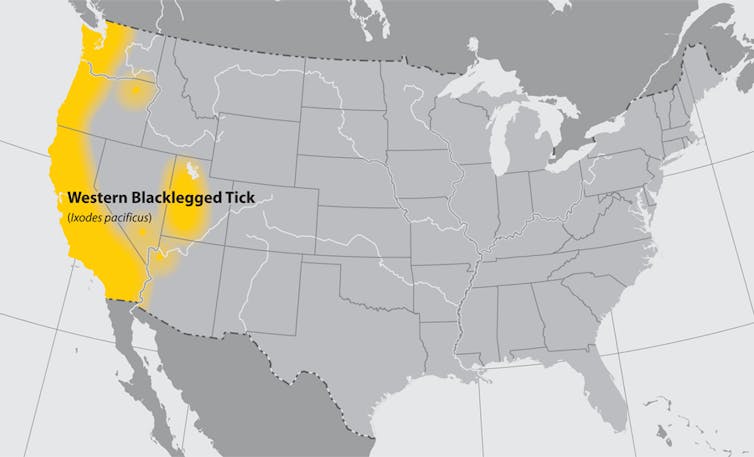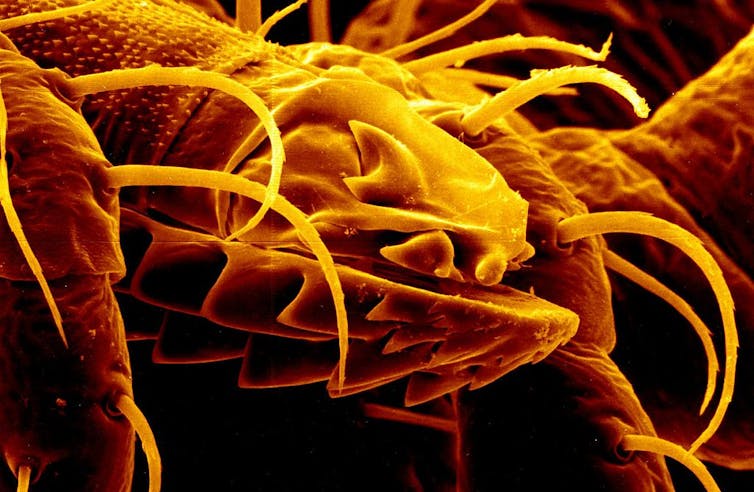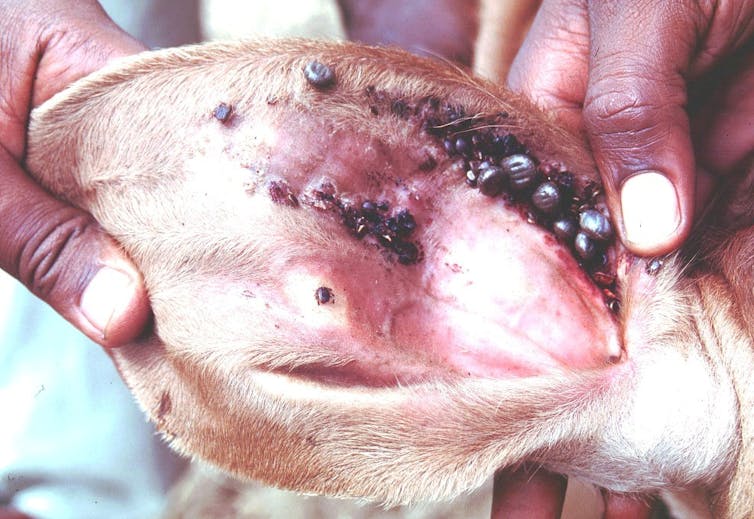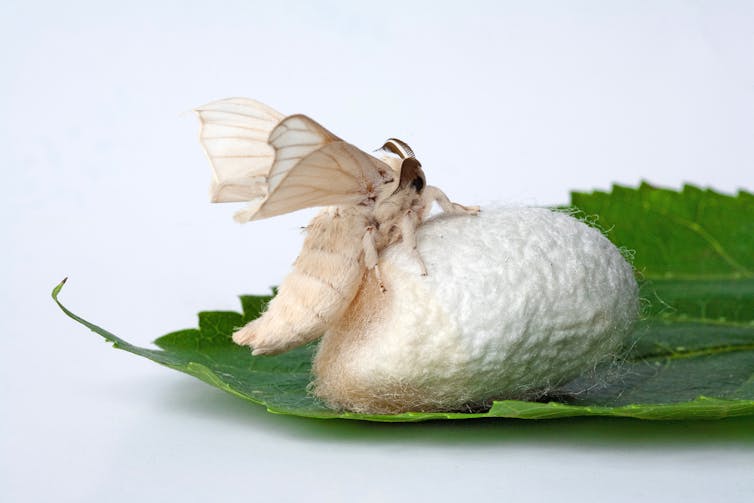
U.S. Centers for Disease Control and Prevention
Sean Lawrence, West Virginia University
When you think about ticks, you might picture nightmarish little parasites, stalking you on weekend hikes or afternoons in the park.
Your fear is well-founded. Tick-borne diseases are the most prevalent vector-borne diseases – those transmitted by living organisms – in the United States. Each tick feeds on multiple animals throughout its life, absorbing viruses and bacteria along the way and passing them on with its next bite. Some of those viruses and bacteria are harmful to humans, causing diseases that can be debilitating and sometimes lethal without treatment, such as Lyme, babesiosis and Rocky Mountain spotted fever.
But contained in every bite of this infuriating, insatiable pest is also a trove of social, environmental and epidemiological history.
In many cases, human actions long ago are the reason ticks carry these diseases so widely today. And that’s what makes ticks fascinating for environmental historians like me.

CDC
Changing forests fueled tick risks
During the 18th and 19th centuries, settlers cleared more than half the forested land across the northeastern U.S., cutting down forests for timber and to make way for farms, towns and mining operations. With large-scale land clearing came a sharp decline in wildlife of all kinds. Predators such as bears and wolves were driven out, as were deer.
As farming moved westward, Northeasterners began to recognize the ecological and economic value of trees, and they returned millions of acres to forest.
The woods regrew. Plant-eaters such as deer returned, but the apex predators that once kept their populations in check did not.
As a result, deer populations grew rapidly. With the deer came deer ticks (Ixodes scapularis) carrying borrelia burgdorferi, the bacterium that causes Lyme disease. When a tick feeds on an infected animal, it can take up the bacteria. The tick can pass the bacteria to its next victim. In humans, Lyme disease can cause fever and fatigue, and if left untreated it can affect the nervous system.
The eastern U.S. became a global hot spot for tick-borne Lyme disease starting around the 1970s. Lyme disease affected over 89,000 Americans in 2023, and possibly many more.
Californians move into tick territory
For centuries, changing patterns of human settlements and the politics of land use have shaped the role of ticks and tick-borne illnesses within their environments.
In short, humans have made it easier for ticks to thrive and spread disease in our midst.
In California, the Northern Inner Coast and Santa Cruz mountain ranges that converge on San Francisco from the north and south were never clear-cut, and predators such as mountain lions and coyotes still exist there. But competition for housing has pushed human settlement deeper into wildland areas to the north, south and east of the city, reshaping tick ecology there.

National Center for Emerging and Zoonotic Infectious Diseases
While western black-legged ticks (Ixodes pacificus) tend to swarm in large forest preserves, the Lyme-causing bacterium is actually more prevalent in small, isolated patches of greenery. In these isolated patches, rodents and other tick hosts can thrive, safe from large predators, which need more habitat to move freely. But isolation and lower diversity also means infections are spread more easily within the tick’s host populations.
People tend to build isolated houses in the hills, rather than large, connected developments. As the Silicon Valley area south of San Francisco sprawls outward, this checkerboard pattern of settlement has fragmented the natural landscape, creating a hard-to-manage public health threat.
Fewer hosts, more tightly packed, often means more infected hosts, proportionally, and thus more dangerous ticks.

National Institute of Allergy and Infectious Diseases
Six counties across these ranges, all surrounding and including San Francisco, account for 44% of recorded tick-borne illnesses in California.
A lesson from Texas cattle ranches
Domesticated livestock have also shaped the disease threat posed by ticks.
In 1892, at a meeting of cattle ranchers at the Stock Raiser’s Convention in Austin, Texas, Dr. B.A. Rogers introduced a novel theory that ticks were behind recent devastating plagues of Texas cattle fever. The disease had arrived with cattle imported from the West Indies and Mexico in the 1600s, and it was taking huge tolls on cattle herds. But how the disease spread to new victims had been a mystery.

Nathan Banks, A treatise on the Acarina, or mites. Proceedings of the United States National Museum
Editors of Daniel’s Texas Medical Journal found the idea of ticks spreading disease laughable and lampooned the hypothesis, publishing a satire of what they described as an “early copy” of a forthcoming report on the subject.
The tick’s “fluid secretion, it is believed, is the poison which causes the fever … [and the tick] having been known to chew tobacco, as all other Texans do, the secretion is most probably tobacco juice,” they wrote.
Fortunately for the ranchers, not to mention the cows, the U.S. Department of Agriculture sided with Rogers. Its cattle fever tick program, started in 1906, curbed cattle fever outbreaks by limiting where and when cattle should cross tick-dense areas.

Alan R Walker, CC BY-NC-SA
By 1938, the government had established a quarantine zone that extended 580 miles by 10 miles along the U.S.-Mexico border in South Texas Brush Country, a region favored by the cattle tick.
This innovative use of natural space as a public health tool helped to functionally eradicate cattle fever from 14 Southern states by 1943.
Ticks are products of their environment
When it comes to tick-borne diseases the world over, location matters.
Take the hunter tick (Hyalomma spp.) of the Mediterranean and Asia. As a juvenile, or nymph, these ticks feed on small forest animals such as mice, hares and voles, but as an adult they prefer domesticated livestock.
For centuries, this tick was an occasional nuisance to nomadic shepherds of the Middle East. But in the 1850s, the Ottoman Empire passed laws to force nomadic tribes to become settled farmers instead. Unclaimed lands, especially on the forested edges of the steppe, were offered to settlers, creating ideal conditions for hunter ticks.
As a result, farmers in what today is Turkey saw spikes in tick-borne diseases, including a virus that causes Crimean-Congo hemorrhagic fever, a potentially fatal condition.
It’s probably too much to ask for sympathy for any ticks you meet this summer. They are bloodsucking parasites, after all.
Still, it’s worth remembering that the tick’s malevolence isn’t its own fault. Ticks are products of their environment, and humans have played many roles in turning them into the harmful parasites that seek us out today.
This article has been updated to clarify that ticks spread alongside the deer population.
Sean Lawrence, Assistant Professor of History, West Virginia University
This article is republished from The Conversation under a Creative Commons license. Read the original article.





























































